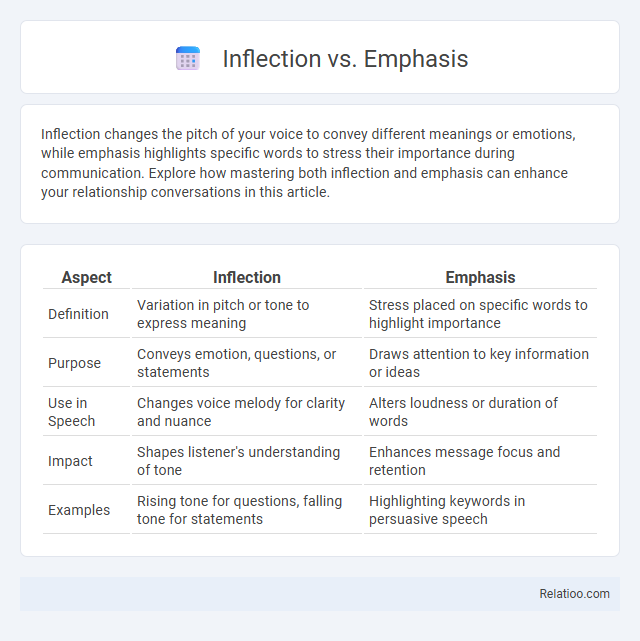Inflection changes the pitch of your voice to convey different meanings or emotions, while emphasis highlights specific words to stress their importance during communication. Explore how mastering both inflection and emphasis can enhance your relationship conversations in this article.
Table of Comparison
| Aspect | Inflection | Emphasis |
|---|---|---|
| Definition | Variation in pitch or tone to express meaning | Stress placed on specific words to highlight importance |
| Purpose | Conveys emotion, questions, or statements | Draws attention to key information or ideas |
| Use in Speech | Changes voice melody for clarity and nuance | Alters loudness or duration of words |
| Impact | Shapes listener's understanding of tone | Enhances message focus and retention |
| Examples | Rising tone for questions, falling tone for statements | Highlighting keywords in persuasive speech |
Understanding Inflection and Emphasis
Inflection involves changing the pitch or tone of the voice to convey different meanings or grammatical distinctions, such as indicating questions or statements. Emphasis highlights specific words or syllables to draw attention and clarify intent, often affecting the emotional impact of a sentence. Understanding how to use inflection and emphasis effectively enhances communication by improving clarity, nuance, and listener engagement.
Key Differences Between Inflection and Emphasis
Inflection refers to the modulation of pitch or tone in spoken language to convey grammatical information or meaning, while emphasis highlights a particular word or phrase to indicate importance or contrast. Inflection changes the word's form, affecting tense, mood, or case, whereas emphasis alters the stress or loudness without modifying the word's structure. Understanding these key differences allows you to interpret and use speech effectively for clear communication and nuanced expression.
The Role of Inflection in Communication
Inflection plays a crucial role in communication by altering the pitch or tone of your voice to convey different meanings and emotions, distinguishing statements, questions, or commands. Unlike emphasis, which highlights specific words to signal importance, inflection provides subtle cues that help listeners interpret intent and mood accurately. Understanding inflection enhances your ability to engage effectively, ensuring your message is clear and appropriately nuanced in verbal interactions.
How Emphasis Shapes Meaning
Emphasis shapes meaning by highlighting specific words or phrases, altering the interpretation of your message and guiding listener attention to critical information. Inflection, through pitch and tone variation, modulates meaning by indicating questions, statements, or emotions without changing word stress. Understanding the interplay between emphasis and inflection enhances your communication clarity and effectiveness in conveying nuanced intent.
Types of Inflection in Language
Inflection in language refers to the modification of words to express different grammatical categories such as tense, case, voice, aspect, person, number, gender, and mood. Types of inflection include conjugation for verbs (e.g., walk, walks, walked), declension for nouns and pronouns (e.g., child, children's), and comparison for adjectives and adverbs (e.g., big, bigger, biggest). Unlike emphasis, which highlights particular words or phrases for stress or importance, inflection structurally alters word forms to convey meaning within sentence grammar.
Techniques for Adding Emphasis
Inflection involves varying pitch to convey meaning, while emphasis highlights specific words or phrases to draw attention. Techniques for adding emphasis include altering volume, elongating vowels, and strategic pausing to create impact. Mastering these vocal variations enhances clarity and emotional expression in speech.
Inflection vs Emphasis in Spoken Language
Inflection in spoken language refers to the variation in pitch or tone that conveys grammatical information or distinguishes between statements and questions, while emphasis highlights specific words or phrases to signal importance or emotion. Inflection typically involves subtle changes in intonation patterns that alter meaning or sentence type, whereas emphasis employs louder volume, elongated vowels, or stress to draw attention. The contrast between inflection and emphasis shapes meaning by either modifying sentence structure or emphasizing message components, crucial for effective verbal communication.
Impact on Listener Interpretation
Inflection alters the pitch or tone of speech, which can change the meaning of a sentence and influence how a listener emotionally perceives the message. Emphasis highlights specific words or phrases through increased volume or stress, directing the listener's attention and clarifying the speaker's intent. Both inflection and emphasis significantly impact listener interpretation by shaping the perceived importance and emotional context of spoken communication.
Common Mistakes in Using Inflection and Emphasis
Common mistakes in using inflection and emphasis often involve confusing pitch variation (inflection) with stress placement (emphasis), leading to unclear communication. You might unintentionally change the meaning of a sentence by stressing the wrong word or using a flat intonation that fails to convey the intended emotion or importance. Mastering the subtle differences enhances your spoken language clarity and effectiveness.
Tips for Mastering Inflection and Emphasis
Mastering inflection and emphasis transforms your spoken communication by adding clarity, emotion, and intent, crucial for engaging your audience effectively. Focus on varying your pitch and stress to highlight key words and convey different meanings, practicing through reading aloud and recording your voice to self-assess. Your ability to control vocal dynamics ensures that your message resonates, making your speech more persuasive and memorable.

Infographic: Inflection vs Emphasis
 relatioo.com
relatioo.com